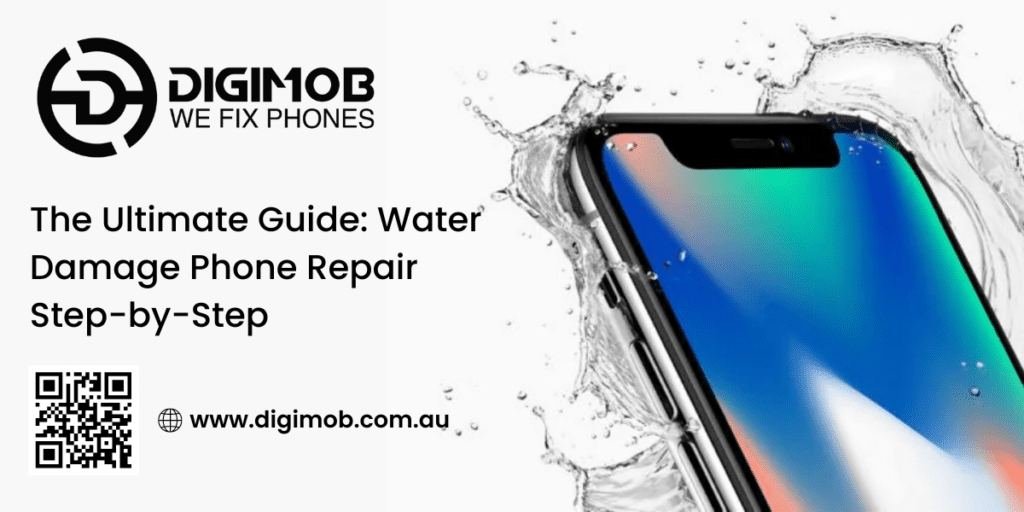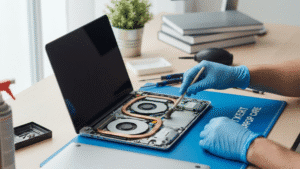Water damage can be a nightmare for any phone owner. Whether it’s a quick dip in the sink or a full submersion in the ocean, water can wreak havoc on your beloved device. However, all hope is not lost! With the right steps, you can potentially save your phone. This guide will walk you through the process of water damage phone repair in easy-to-understand language.

Step 1: Act Quickly
The first thing to remember is to act fast. The longer your phone stays wet, the more damage it can sustain.
- Remove from Water: Get your phone out of the water as quickly as possible.
- Turn It Off: If it’s still on, turn it off immediately. This helps prevent a short circuit.
- Remove Case and Accessories: Take off any case, and remove SIM cards, SD cards, and any other accessories.
Step 2: Dry the Exterior
Once your phone is out of the water, it’s important to dry the exterior thoroughly.
- Use a Cloth: Gently wipe the phone with a soft, absorbent cloth.
- Avoid Shaking: Do not shake the phone to get water out, as this can push water further inside.
- Skip the Hairdryer: Avoid using a hairdryer or any other heat source, as this can cause further damage.
Step 3: Remove Moisture from Inside
Now that the exterior is dry, it’s time to tackle the moisture inside the phone.
- Use Silica Gel Packets: Place your phone in a container filled with silica gel packets. These are more effective than rice at absorbing moisture.
- Leave It to Dry: Allow your phone to sit in the container for at least 24-48 hours. Patience is key here.
Step 4: Check for Damage
After giving your phone ample time to dry, it’s time to see if it has survived.
- Visual Inspection: Look for any signs of residual moisture or corrosion.
- Power It On: Try turning the phone on. If it powers up, check all the functions – screen, speakers, microphone, and cameras.
Step 5: Seek Professional Help
If your phone doesn’t turn on, or if it shows signs of malfunction, it’s time to get professional help.
- Visit a Repair Shop: Take your phone to a reputable repair service. Professionals have the tools and expertise to deal with water damage more effectively.
- Data Recovery: If the phone is beyond repair, they may still be able to recover your data.
Preventing Future Water Damage
Taking steps to prevent water damage in the future can save you a lot of headaches.
- Use a Waterproof Case: Investing in a good waterproof case can protect your phone from accidental splashes and submersions.
- Be Mindful Around Water: Always be cautious when using your phone near water – pools, beaches, and even bathrooms can be risky.
The Importance of Acting Quickly
Time is of the essence when dealing with water damage. The longer your phone remains wet, the higher the risk of permanent damage. Water can seep into the internal components, causing short circuits and corrosion. Immediate action can prevent these issues from escalating. So, if your phone gets wet, remember to remove it from the water and turn it off right away. This initial step can make a significant difference in the outcome.
Proper Drying Techniques
While it might be tempting to use a hairdryer or place your phone in the sun to speed up the drying process, these methods can cause more harm than good. Excessive heat can damage the delicate components inside your phone. Instead, use a soft cloth to dry the exterior and let silica gel packets do the work for the interior. These packets are highly effective at absorbing moisture and are a safer alternative to rice, which can leave dust and starch particles inside your phone.
Patience is Key
Allowing your phone ample time to dry out completely is crucial. Even if it looks dry on the outside, moisture could still be lurking inside. Resist the urge to turn it on prematurely, as this could cause a short circuit. Leave your phone in a container with silica gel packets for at least 24-48 hours. This patience can often mean the difference between a fully functional phone and one that needs extensive repairs.
Knowing When to Seek Help
Sometimes, despite your best efforts, DIY methods may not be enough. If your phone doesn’t turn on after drying or exhibits strange behaviour, it’s time to seek professional assistance. Experienced technicians have the tools and knowledge to diagnose and repair water damage effectively. They can also perform data recovery if the phone is irreparable, ensuring that your important files and memories are not lost.
Long-Term Care and Prevention
Once you’ve successfully repaired your water-damaged phone, taking steps to prevent future incidents is wise. Invest in a high-quality waterproof case to provide extra protection. Be cautious when using your phone near water and consider leaving it in a safe place when you’re at the beach or pool. By being proactive and mindful, you can safeguard your phone from future water damage and extend its lifespan.
Water damage is a common issue that can be managed effectively with the right approach. Acting quickly, using proper drying techniques, being patient, knowing when to seek professional help, and taking preventative measures can all contribute to saving your phone from water damage. Keep these steps in mind, and you’ll be better prepared to handle any accidental water exposure your phone might encounter.
Do you have gadget glitches? No worries! ????️ From laptops ????️ to iPhones ????, MacBooks ???? to iPads, and even Samsung, Android phones, and all other major brands, we’ve got you covered! ???? Our team offers swift and reliable repairs for all your digital needs. ???? Visit digimob.com.au today!
Conclusion
Water damage is a common but manageable problem. By following these steps, you can increase the chances of rescuing your phone. Remember, acting quickly and allowing thorough drying are crucial. If all else fails, professional repair services are there to help. Stay vigilant and keep your phone safe from water hazards!


